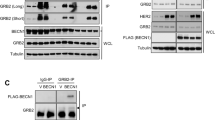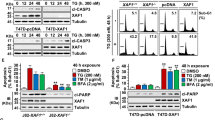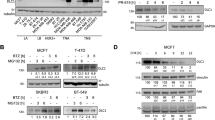Abstract
Despite the established role of insulin-like growth factor binding protein-3 (IGFBP-3) as a growth inhibitor in vitro, a high level of IGFBP-3 in breast tumor tissue is associated with the stimulation of xenograft growth in mice and poor prognosis in patients. To understand the contribution of IGFBP-3 to breast cancer progression, tandem affinity purification was used to identify novel interacting proteins. The endoplasmic reticulum protein, glucose-regulated protein 78 (GRP78), was shown to bind to IGFBP-3, confirmed by colocalization, coimmunoprecipitations, glutathione S-transferase (GST) pulldowns and a nanomolar binding affinity. GST pulldowns also indicated that the GRP78 ATPase domain mediated the interaction with IGFBP-3. The critical roles of GRP78 in the unfolded protein response and macroautophagy led to an investigation of possible links between IGFBP-3, GRP78 and cellular stress responses. IGFBP-3 was found to stimulate the survival of breast cancer cells subjected to glucose starvation and hypoxia. Pharmacological inhibitors and small interfering RNA knockdown established that the increased survival of IGFBP-3-expressing cells was dependent on an intact autophagy response, as well as GRP78. The contribution of autophagy was confirmed by the demonstration that IGFBP-3 expression increases both the formation of autophagic puncta and flux through the system. In conclusion, we have shown that IGFBP-3 stimulates autophagy and thereby promotes the survival of breast cancer cells exposed to conditions that represent the adverse microenvironments encountered by solid tumor cells in vivo.
This is a preview of subscription content, access via your institution
Access options
Subscribe to this journal
Receive 50 print issues and online access
$259.00 per year
only $5.18 per issue
Buy this article
- Purchase on Springer Link
- Instant access to full article PDF
Prices may be subject to local taxes which are calculated during checkout






Similar content being viewed by others
References
Firth SM, Baxter RC . Cellular actions of the insulin-like growth factor binding proteins. Endocr Rev 2002; 23: 824–854.
Chen W, Wang S, Tian T, Bai J, Hu Z, Xu Y et al. Phenotypes and genotypes of insulin-like growth factor 1, IGF-binding protein-3 and cancer risk: evidence from 96 studies. Eur J Hum Genet 2009; 17: 1668–1675.
Sheen-Chen SM, Zhang H, Huang CC, Tang RP . Insulin-like growth factor-binding protein-3 in breast cancer: analysis with tissue microarray. Anticancer Res 2009; 29: 1131–1135.
Yu H, Levesque MA, Khosravi MJ, Papanastasiou-Diamandi A, Clark GM, Diamandis EP . Associations between insulin-like growth factors and their binding proteins and other prognostic indicators in breast cancer. Br J Cancer 1996; 74: 1242–1247.
Rocha RL, Hilsenbeck SG, Jackson JG, Vandenberg CL, Weng CN, Lee AV et al. Insulin-like growth factor binding protein-3 and insulin receptor substrate-1 in breast cancer–correlation with clinical parameters and disease-free survival. Clin Cancer Res 1997; 3: 103–109.
Vestey SB, Perks CM, Sen C, Calder CJ, Holly JM, Winters ZE . Immunohistochemical expression of insulin-like growth factor binding protein-3 in invasive breast cancers and ductal carcinoma in situ: implications for clinicopathology and patient outcome. Breast Cancer Res 2005; 7: R119–R129.
Liu B, Weinzimer SA, Gibson TB, Mascarenhas D, Cohen P . Type Ialpha collagen is an IGFBP-3 binding protein. Growth Horm IGF Res 2003; 13: 89–97.
Gui Y, Murphy LJ . Insulin-like growth factor (IGF)-binding protein-3 (IGFBP-3) binds to fibronectin (FN): demonstration of IGF-I/IGFBP-3/fn ternary complexes in human plasma. J Clin Endocrinol Metab 2001; 86: 2104–2110.
Weinzimer SA, Gibson TB, Collett-Solberg PF, Khare A, Liu B, Cohen P . Transferrin is an insulin-like growth factor-binding protein-3 binding protein. J Clin Endocrinol Metab 2001; 86: 1806–1813.
Ikonen M, Liu B, Hashimoto Y, Ma L, Lee KW, Niikura T et al. Interaction between the Alzheimer's survival peptide humanin and insulin-like growth factor-binding protein 3 regulates cell survival and apoptosis. Proc Natl Acad Sci USA 2003; 100: 13042–13047.
Liu B, Lee HY, Weinzimer SA, Powell DR, Clifford JL, Kurie JM et al. Direct functional interactions between insulin-like growth factor-binding protein-3 and retinoid X receptor-a regulate transcriptional signaling and apoptosis. J Biol Chem 2000; 275: 33607–33613.
Oufattole M, Lin SW, Liu B, Mascarenhas D, Cohen P, Rodgers BD . Ribonucleic acid polymerase II binding subunit 3 (Rpb3), a potential nuclear target of insulin-like growth factor binding protein-3. Endocrinology 2006; 147: 2138–2146.
Chan SS, Schedlich LJ, Twigg SM, Baxter RC . Inhibition of adipocyte differentiation by insulin-like growth factor-binding protein-3. Am J Physiol Endocrinol Metab 2009; 296: E654–E663.
Perks CM, Holly JM . IGF binding proteins (IGFBPs) and regulation of breast cancer biology. J Mammary Gland Biol Neoplasia 2008; 13: 455–469.
Jogie-Brahim S, Feldman D, Oh Y . Unraveling insulin-like growth factor binding protein-3 actions in human disease. Endocr Rev 2009; 30: 417–437.
Firth SM, Fanayan S, Benn D, Baxter RC . Development of resistance to insulin-like growth factor binding protein-3 in transfected T47D breast cancer cells. Biochem Biophys Res Commun 1998; 246: 325–329.
Fanayan S, Firth SM, Butt AJ, Baxter RC . Growth inhibition by insulin-like growth factor-binding protein-3 in T47D breast cancer cells requires transforming growth factor-beta (TGF-beta) and the type II TGF-beta receptor. J Biol Chem 2000; 275: 39146–39151.
Li J, Ni M, Lee B, Barron E, Hinton DR, Lee AS . The unfolded protein response regulator GRP78/BiP is required for endoplasmic reticulum integrity and stress-induced autophagy in mammalian cells. Cell Death Differ 2008; 15: 1460–1471.
Lee AS . GRP78 induction in cancer: therapeutic and prognostic implications. Cancer Res 2007; 67: 3496–3499.
Fernandez PM, Tabbara SO, Jacobs LK, Manning FC, Tsangaris TN, Schwartz AM et al. Overexpression of the glucose-regulated stress gene GRP78 in malignant but not benign human breast lesions. Breast Cancer Res Treat 2000; 59: 15–26.
Dong D, Ni M, Li J, Xiong S, Ye W, Virrey JJ et al. Critical role of the stress chaperone GRP78/BiP in tumor proliferation, survival, and tumor angiogenesis in transgene-induced mammary tumor development. Cancer Res 2008; 68: 498–505.
Firth SM, Baxter RC . The role of glycosylation in the action of IGFBP-3. Prog Growth Factor Res 1995; 6: 223–229.
Wisniewska M, Karlberg T, Lehtio L, Johansson I, Kotenyova T, Moche M et al. Crystal structures of the ATPase domains of four human Hsp70 isoforms: HSPA1L/Hsp70-hom, HSPA2/Hsp70-2, HSPA6/Hsp70B′, and HSPA5/BiP/GRP78. PLoS One 2010; 5: e8625.
Schroder M, Kaufman RJ . The mammalian unfolded protein response. Annu Rev Biochem 2005; 74: 739–789.
Reddy RK, Mao C, Baumeister P, Austin RC, Kaufman RJ, Lee AS . Endoplasmic reticulum chaperone protein GRP78 protects cells from apoptosis induced by topoisomerase inhibitors: role of ATP binding site in suppression of caspase-7 activation. J Biol Chem 2003; 278: 20915–20924.
Fu Y, Li J, Lee AS . GRP78/BiP inhibits endoplasmic reticulum BIK and protects human breast cancer cells against estrogen starvation-induced apoptosis. Cancer Res 2007; 67: 3734–3740.
Gonzalez-Gronow M, Selim MA, Papalas J, Pizzo SV . GRP78: a multifunctional receptor on the cell surface. Antioxid Redox Signal 2009; 11: 2299–2306.
Kim HS, Lee WJ, Lee SW, Chae HW, Kim DH, Oh Y . Insulin-like growth factor binding protein-3 induces G1 cell cycle arrest with inhibition of cyclin-dependent kinase 2 and 4 in MCF-7 human breast cancer cells. Horm Metab Res 2010; 42: 165–172.
Butt AJ, Martin JL, Dickson KA, McDougall F, Firth SM, Baxter RC . Insulin-like growth factor binding protein-3 expression is associated with growth stimulation of T47D human breast cancer cells: the role of altered epidermal growth factor signalling. J Clin Endocrinol Metab 2004; 89: 1950–1956.
Criollo A, Maiuri MC, Tasdemir E, Vitale I, Fiebig AA, Andrews D et al. Regulation of autophagy by the inositol trisphosphate receptor. Cell Death Differ 2007; 14: 1029–1039.
DiPaola RS, Dvorzhinski D, Thalasila A, Garikapaty V, Doram D, May M et al. Therapeutic starvation and autophagy in prostate cancer: a new paradigm for targeting metabolism in cancer therapy. Prostate 2008; 68: 1743–1752.
Dalby KN, Tekedereli I, Lopez-Berestein G, Ozpolat B . Targeting the prodeath and prosurvival functions of autophagy as novel therapeutic strategies in cancer. Autophagy 2010; 6: 322–329.
Wu YT, Tan HL, Shui G, Bauvy C, Huang Q, Wenk MR et al. Dual role of 3-methyladenine in modulation of autophagy via different temporal patterns of inhibition on class I and III phosphoinositide 3-kinase. J Biol Chem 2010; 285: 10850–10861.
Lipinski MM, Hoffman G, Ng A, Zhou W, Py BF, Hsu E et al. A genome-wide siRNA screen reveals multiple mTORC1 independent signaling pathways regulating autophagy under normal nutritional conditions. Dev Cell 2010; 18: 1041–1052.
Yang Z, Klionsky DJ . An overview of the molecular mechanism of autophagy. Curr Top Microbiol Immunol 2009; 335: 1–32.
Klionsky DJ, Abeliovich H, Agostinis P, Agrawal DK, Aliev G, Askew DS et al. Guidelines for the use and interpretation of assays for monitoring autophagy in higher eukaryotes. Autophagy 2008; 4: 151–175.
Ma Y, Hendershot LM . The role of the unfolded protein response in tumour development: friend or foe? Nat Rev Cancer 2004; 4: 966–977.
Feldman DE, Chauhan V, Koong AC . The unfolded protein response: a novel component of the hypoxic stress response in tumors. Mol Cancer Res 2005; 3: 597–605.
Lee E, Nichols P, Spicer D, Groshen S, Yu MC, Lee AS . GRP78 as a novel predictor of responsiveness to chemotherapy in breast cancer. Cancer Res 2006; 66: 7849–7853.
Scriven P, Coulson S, Haines R, Balasubramanian S, Cross S, Wyld L . Activation and clinical significance of the unfolded protein response in breast cancer. Br J Cancer 2009; 101: 1691698–7853.
Wang M, Wey S, Zhang Y, Ye R, Lee AS . Role of the unfolded protein response regulator GRP78/BiP in development, cancer and neurological disorders. Antioxid Redox Signal 2009; 11: 2307–2316.
Butt AJ, Fraley KA, Firth SM, Baxter RC . IGF-binding protein-3-induced growth inhibition and apoptosis do not require cell surface binding and nuclear translocation in human breast cancer cells. Endocrinology 2002; 143: 2693–2699.
O'Han MK, Baxter RC, Schedlich LJ . Effects of endogenous insulin-like growth factor binding protein-3 on cell cycle regulation in breast cancer cells. Growth Factors 2009; 27: 394–408.
Itakura E, Mizushima N . Characterization of autophagosome formation site by a hierarchical analysis of mammalian Atg proteins. Autophagy 2010; 6: 764–776.
Espina V, Liotta LA . What is the malignant nature of human ductal carcinoma in situ? Nat Rev Cancer 2011; 11: 68–75.
Ren Z, Shin A, Cai Q, Shu XO, Gao YT, Zheng W . IGFBP3 mRNA expression in benign and malignant breast tumors. Breast Cancer Res 2007; 9: R2.
Firth SM, Baxter RC . Characterisation of recombinant glycosylation variants of insulin-like growth factor binding protein-3. J Endocrinol 1999; 160: 379–387.
Grimberg A, Coleman CM, Burns TF, Himelstein BP, Koch CJ, Cohen P et al. p53-Dependent and p53-independent induction of insulin-like growth factor binding protein-3 by deoxyribonucleic acid damage and hypoxia. J Clin Endocrinol Metab 2005; 90: 3568–3574.
Feldser D, Agani F, Iyer NV, Pak B, Ferreira G, Semenza GL . Reciprocal positive regulation of hypoxia-inducible factor 1alpha and insulin-like growth factor 2. Cancer Res 1999; 59: 3915–3918.
Yu H, Levesque MA, Khosravi MJ, Papanastasiou-Diamandi A, Clark GM, Diamandis EP . Insulin-like growth factor-binding protein-3 and breast cancer survival. Int J Cancer 1998; 79: 624–628.
Martin JL, Lin MZ, McGowan EM, Baxter RC . Potentiation of growth factor signaling by insulin-like growth factor-binding protein-3 in breast epithelial cells requires sphingosine kinase activity. J Biol Chem 2009; 284: 25542–25552.
McIntosh J, Dennison G, Holly JM, Jarrett C, Frankow A, Foulstone EJ et al. IGFBP-3 can either inhibit or enhance EGF-mediated growth of breast epithelial cells dependent upon the presence of fibronectin. J Biol Chem 2010; 285: 38788–38800.
Brunner M . Regulation of DNA synthesis by amino acid limitation. Cancer Res 1973; 33: 29–32.
Fung C, Lock R, Gao S, Salas E, Debnath J . Induction of autophagy during extracellular matrix detachment promotes cell survival. Mol Biol Cell 2008; 19: 797–806.
Mendez J, Stillman B . Chromatin association of human origin recognition complex, cdc6, and minichromosome maintenance proteins during the cell cycle: assembly of prereplication complexes in late mitosis. Mol Cell Biol 2000; 20: 8602–8612.
Kratzner R, Frohlich F, Lepler K, Schroder M, Roher K, Dickel C et al. A peroxisome proliferator-activated receptor gamma-retinoid X receptor heterodimer physically interacts with the transcriptional activator PAX6 to inhibit glucagon gene transcription. Mol Pharmacol 2008; 73: 509–517.
Schedlich LJ, O'Han MK, Leong GM, Baxter RC . Insulin-like growth factor binding protein-3 prevents retinoid receptor heterodimerization: implications for retinoic acid-sensitivity in human breast cancer cells. Biochem Biophys Res Commun 2004; 314: 83–88.
Firth SM, Ganeshprasad U, Baxter RC . Structural determinants of ligand and cell surface binding of insulin-like growth factor binding protein-3. J Biol Chem 1998; 273: 2631–2638.
Schedlich LJ, Muthukaruppan A, O'Han MK, Baxter RC . Insulin-like growth factor binding protein-5 interacts with the vitamin D receptor and modulates the vitamin D response in osteoblasts. Mol Endocrinol 2007; 21: 2378–2390.
Kaminskyy V, Abdi A, Zhivotovsky B . A quantitative assay for the monitoring of autophagosome accumulation in different phases of the cell cycle. Autophagy 2011; 7: 83–90.
Acknowledgements
We thank G Lu for his assistance with immunocytochemistry. SG and SMF were recipients of Cancer Institute NSW Early Career and Career Development Fellowships, respectively. SH and MH received Summer Research Scholarships from the Sydney Medical School, University of Sydney. This project was partly supported by the Allan and Beryl Stephens Trust and University of Sydney Bridging Support Grant.
Author information
Authors and Affiliations
Corresponding author
Ethics declarations
Competing interests
The authors declare no conflict of interest.
Additional information
Supplementary Information accompanies the paper on the Oncogene website
Supplementary information
Rights and permissions
About this article
Cite this article
Grkovic, S., O'Reilly, V., Han, S. et al. IGFBP-3 binds GRP78, stimulates autophagy and promotes the survival of breast cancer cells exposed to adverse microenvironments. Oncogene 32, 2412–2420 (2013). https://doi.org/10.1038/onc.2012.264
Received:
Revised:
Accepted:
Published:
Issue Date:
DOI: https://doi.org/10.1038/onc.2012.264
Keywords
This article is cited by
-
IGFBP-3 interacts with NONO and SFPQ in PARP-dependent DNA damage repair in triple-negative breast cancer
Cellular and Molecular Life Sciences (2019)
-
Mitochondrial ATAD3A combines with GRP78 to regulate the WASF3 metastasis-promoting protein
Oncogene (2016)
-
Endoplasmic reticulum chaperone GRP78 is involved in autophagy activation induced by ischemic preconditioning in neural cells
Molecular Brain (2015)
-
GRP78 promotes the invasion of pancreatic cancer cells by FAK and JNK
Molecular and Cellular Biochemistry (2015)
-
The role of insulin-like growth factor binding protein-3 in the breast cancer cell response to DNA-damaging agents
Oncogene (2014)



